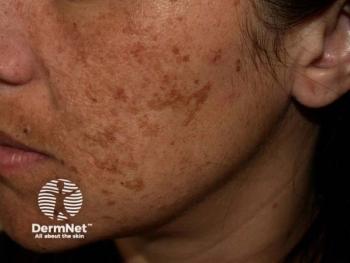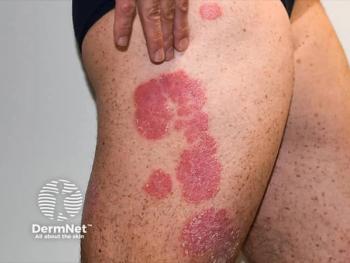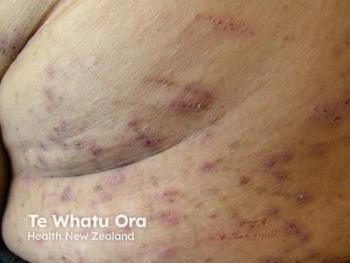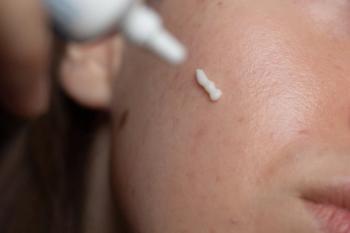
Remibrutinib Shows Rapid and Sustained Improvement in CSU Activity Score Bands
Key Takeaways
- Remibrutinib significantly reduces CSU symptoms, with rapid improvement in UAS7 bands observed as early as week 1.
- Sustained symptom improvement was maintained over 52 weeks, with many patients achieving well-controlled or complete response.
New findings at Elevate Derm highlight remibrutinib's rapid and sustained efficacy in reducing chronic spontaneous urticaria symptoms, offering hope for patients.
In a poster presented at the
Background
Remibrutinib is a novel, highly selective, oral Bruton’s tyrosine kinase inhibitor. Previous data presented at the 2024 European Academy of Allergy and Clinical Immunology (EAACI) demonstrated the drug’s superior effectiveness when compared to placebo. The phase 3 global, double-blind, placebo-controlled REMIX-1 and REMIX-2 trials showed high efficacy and safety after 12 and 24 weeks, specifically in patients who remained symptomatic even after treatment with second-generation H1-antihistamines.2 Another REMIX analysis observed a reduction in CSU disease activity as early as week 1. This improvement was sustained up to 24 weeks in patients with moderate to severe disease.3
Methods & Materials
The latest post-hoc analysis further explored the REMIX studies, assessing weekly UAS7 bands in patients being treated with both remibrutinib and placebo twice daily for up to 52 weeks from baseline.
Patients were randomized 2:1 to oral remibrutinib 25 mg bid (n = 606) or placebo (n = 306) for 24 weeks, followed by an open-label treatment with remibrutinib 25 mg bid for 28 weeks. Patients on placebo transitioned to remibrutinib at week 24. At baseline, 35% and 63.7% of participants taking remibrutinib had moderate and severe disease activity, respectively. In the placebo arm, 39.9% had moderate disease and 59.2% had severe symptoms.
CSU disease activity was categorized into five bands:
- UAS7 = 0, Complete response
- UAS7 > 0–6, Well-controlled disease activity
- UAS7 > 6–<16, Mild disease activity
- UAS7 = 16–<28, Moderate disease activity
- UAS7 = 28–42, Severe disease activity
Results
Patients who treated with remibrutinib for the entire study saw substantial improvements in CSU symptoms, thus moving to a lower disease activity band as early as week 1. More patients remained in lower bands up to the 24th week. Patients who began with placebo and then transitioned to remibrutinib after week 24 then moved to a lower disease band and remained there, indicating no disease remission.
Approximately 63.7% of patients began the trial in the severe band. This dropped to 24.9% at week 1, 17.2% at week 2, 9.1% at week 12, 7.8% at week 24, and then 8.1% at week 52. Additionally, the 35.5% proportion of patients in the moderate band then dropped to 30.7% at week 1, 24.1% at week 2, 10.6% at week 12, 7.9% at week 24, and 7.3% at week 52.
Almost 12% of patients reached well-controlled or complete response at week 1. This rose to 31.5% after 2 weeks. In comparison, 0.7% and 4.2% of placebo-users reached the same response and weeks 1 and 2, respectively. By week 52, 35.1% of respondents had complete improvements. Patients who transitioned from placebo to remibrutinib then achieved similar band shifts.
Conclusion
Overall, patients with CSU who were treated with remibrutinib saw reduced disease activity as early as week 1 when compared to placebo. This fast response became long-term and improvement was sustained for the rest of the study. Additionally, patients who were originally treated with placebo and then switched reached similar levels of well-controlled and complete response by week 52. According to the authors, “remibrutinib has the potential to become a novel oral treatment option that provides fast (as early as week 1) and sustained improvements in disease activity in patients with CSU.”
References
1. Maurer M, et al. CSU Disease Activity Band Shift after Long-Term Treatment With Remibrutinib in the Phase 3 REMIX-1 and REMIX-2 Studies. Poster presented at Elevate-Derm Summer Conference, July 23-27, 2025, Park City, UT
2. Zuberbier Metz M, et al. Oral presentation at: EACCI 2024; 31 May–03 June 2024; Valencia, Spain. Abstract 100107.
3. Maurer M, et al. Oral presentation at: EACCI 2024; 31 May–03 June 2024; Valencia, Spain. Abstract 000439.
Newsletter
Like what you’re reading? Subscribe to Dermatology Times for weekly updates on therapies, innovations, and real-world practice tips.


















